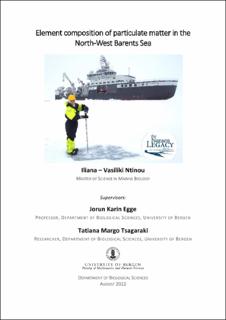| dc.description.abstract | At the dawn of the 21st century, the Arctic Ocean ecosystem is at great risk due to rapid climatic change. The ice edge retreat observed in the Barents Sea and other sub-Arctic areas is so substantial that has led researchers to characterise them as global warming hotspots. Therefore, there is an immediate need to increase our knowledge on the availability of elements, and especially those in the particulate pool to understand the aftermath of loss of sea ice in those areas. The samples and data for this thesis, were provided through the Nansen Legacy research project “The living Barents Sea”, whose focus is to characterize the biological communities and processes of the northern Barents Sea and adjacent Arctic Basin. During two summer cruises with contrasting ice conditions the particulate concentration for P, S, O, Na, Mg, Cl, K, Ca, Si, Fe, Mn, Cu, and Zn, was measured with wavelength dispersive X-ray fluorescence spectroscopy along the study transect to map their distribution. A series of Pearson’s correlation tests revealed two groups of elements, one associated with living material in the euphotic zone (2018: P-S-Ca & 2019: P-S-Mg-K-Na-Cl) and one with a greater prominence in the deeper samples (2018: Si-O-Fe-Mn-K-Mg & 2019: Si-Fe-O-Mn ) suggesting resuspension of particulate matter. Canonical Correspondence Analysis with complementary biological and hydrographical data further confirmed these patterns and uncovered more detailed information about how the distribution of elements in the particulate pool is linked to biogenic sources in the study area. Examination of samples using a Scanning Electron Microscope revealed the most dominant organisms in the study area each year as well as supporting evidence of strong Atlantic influence in 2018 and the impact of sea ice in 2019 as shown with elemental patterns. These patterns and the investigation of their link with hydrographical and biological factors presented here provide an elaborate overview of the particulate elemental composition in the North-West Barents Sea and contribute to further understanding of the potential effects of loss of sea ice in that area. | |
